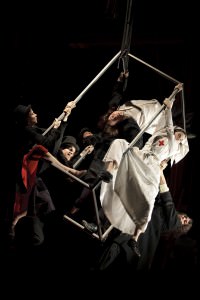Take key events of the past century. Add some music by a Russian composer. Throw in television, radio, and video game transmissions and broadcasts. Frame it with Marc Chagall’s paintings, focusing on the floating brides and animals. Finally, mix in some incredibly talented physical performers skilled in circus arts, dance, and more. Give them some silks from which to suspend themselves, a host of costume changes, and a great deal of conflict. Though it may seem surreal, it is neither “only” a pleasant dream nor a nightmare: welcome to the twentieth century- that is, The Grand Parade (of the 20th Century), a project by Double Edge Theatre currently playing at Arena Stage.

This fantastically circus-like piece has been in development at Double Edge Theatre since the fall of 2010 and has been workshopped in multiple locations, both at their Farm Center and elsewhere. One can tell that the group has not only worked together for years but lives together, as well, as much of the choreography and blocking requires a great deal of trust and instinct between performers. (The artists of Double Edge Theatre call a rural Farm in Ashfield, Massachusetts, home. There, they do site-specific work, in addition to touring their shows.)
The work chronicles the decades and major events of the twentieth century, both within the United States and abroad, including the U.S.’s relationship with Russia. Klein mentions in her production notes that, when considering this timeframe, the group “encountered a brutal and chaotic century, one in which cataclysm and destruction branded the times.” True, the action is often chaotic and, in a way, harsh, both destruction and creation, yet the story is well told. Gifted actors Adam Bright, Hayley Brown, Milena Dabova, Jeremy Louise Eaton, Matthew Glassman, and Carlos Uriona enact the episodes in an abstract fashion via dance, trapeze and silk work, and other blocking, largely without any dialogue except for pure sounds and occasional mutterings. Carroll Durand, the puppet designer, stands by as attendant, with visionary director and designer Stacy Klein, who is also the founder and Artistic Director of the theatre.
Prior to the performance, Klein mentions that they wished to create a living painting. At the start of the show, a large painted canvas begins to move as if it is, indeed, a living painting, as the actors swing while suspended on stage. Collaboration between talented designers Jeff Bird (furniture and wood), Lucrecia Briceno (lighting), Anshuman Bhatia (associate lighting), Adam Bright (technical), Carroll Durand (puppets), Brian Fairley (sound and projection), Beckie Kravetz (masks), Amanda Miller (costumes), and the Double Edge Ensemble (metal apparatus) fused well together to infuse life- and death- into otherwise still paintings. Additionally, direction by Stacy Klein, music and vocal direction by Lyudmila Bakshi, technical design and direction by Adam Bright, and associate technical and lighting director Andrew Todd add well to this dream (or is it a nightmare?) come to life.

The cast of Double Edge Theatre’s The Grand Parade (of the 20th Century). Photo by Maria Baranova.
Sounds filter almost overwhelmingly from a myriad of sources onstage: from the actors’ themselves, from musicians onstage, and from radio and television recordings. Russian composer Alexander Bakshi designed the music, which winds together both elegantly and chaotically. Fittingly, the show’s next performance will be in Moscow.
The Grand Parade (of the 20th Century) is what those who desire challenging, “nontraditional” theatre, like myself, dream about – and, once the performance begins, you have just sixty minutes to pleasantly ponder the dream and the mythology, after which you will be left with Klein’s question: “How, then, will we write the future?” Will it be, as she asks, “destruction or creation?”
Running Time: One hour, with no intermission.
The Grand Parade (of the 20th Century) plays through February 10, 2013 at Arena Stage at The Mead Center for American Theater – 1101 Sixth Street, SW, in Washington, DC. According to Arena Stage’s website, all remaining performances are now sold out.




